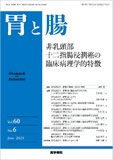Japanese
English
- 有料閲覧
- Abstract 文献概要
- 1ページ目 Look Inside
- 参考文献 Reference
要旨●非乳頭部十二指腸粘膜下層浸潤癌(SM癌)の臨床病理学的特徴を明らかにするために,多施設で収集した非乳頭部十二指腸癌165病変(M癌70病変,SM癌11病変,進行癌84病変)を対象として検討を行った.SM癌は,腫瘍径10mm以下の小さな病変が比較的多く,すべてVater乳頭口側に存在していたのに対し,M癌ではVater乳頭口側と肛門側にほぼ等しく分布していた.進行癌はSM癌と同様にVater乳頭口側に多く存在した.粘液形質は,SM癌は胃型形質と強い関連性を認めたが,一方でM癌は腸型形質が多かった.さらに未分化型癌はSM癌,進行癌には認められたが,M癌はすべて分化型癌であった.Vater乳頭口側の胃型形質を持つ非乳頭部十二指腸癌は,早期にSM以深浸潤癌へと進展する可能性を持った悪性度の非常に高い腫瘍であると考えられる.
Although submucosal invasive nonampullary duodenal carcinoma is an early and important stage of invasive carcinoma, information on clinicopathological characteristics is limited due to the rarity of the disease. We compared the clinicopathological characteristics, including mucin phenotypes, of submucosal invasive carcinoma(SM-Ca), mucosal carcinoma(M-Ca), and advanced carcinoma(Ad-Ca). This research examined 165 patients with sporadic nonampullary duodenal carcinomas(SNADCs)from four institutions between January 2003 and December 2018. Of the 165 SNADCs, 11(7%)were categorized as SM-Ca, 70(42%)as M-Ca, and 84(51%)as Ad-Ca. All SM-Ca and most Ad-Ca lesions were found in the oral-Vater ; however, M-Ca lesions were distributed almost evenly between the oral- and anal-Vater. There was no significant difference in tumor diameter between M-Ca and SM-Ca. However, 45%(5/11)of SM-Ca were ≤10mm. A total of 73%(8/11)of SM-Ca were categorized as gastric phenotype, with no lesions classified as intestinal phenotype ; however, the majority of M-Ca were classified as intestinal phenotype(67%, 8/12). In contrast to M-Ca, SM-Ca was strongly linked to the oral-Vater and gastric mucin phenotype, implying that the carcinogenesis pathway differs between mucosal and invasive carcinomas based on tumor location and mucin phenotype.

Copyright © 2025, Igaku-Shoin Ltd. All rights reserved.


